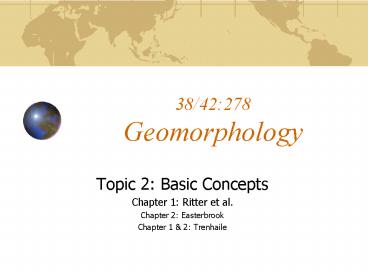3842:278 Geomorphology
1 / 28
Title: 3842:278 Geomorphology
1
38/42278Geomorphology
- Topic 2 Basic Concepts
- Chapter 1 Ritter et al.
- Chapter 2 Easterbrook
- Chapter 1 2 Trenhaile
2
1) Equilibrium
- Balance or equilibrium exists between landform
and process
3
1) Equilibrium
- Gilbert (1877) - landforms reflect balance b/w
climate and geology - No change in landform if no change in process
4
1) Equilibrium
- Davis (1909) cycle of erosion
- Landscapes evolve through stages
- Youth
- Maturity
- Old Age
- Replaces Gilberts theory
5
Youth
- Medium relief
- Many small tributaries
- Turbulent flow
- Original surface preserved
- Deep narrow valleys
- Downwasting
6
Maturity
- Maximum relief
- More tributaries
- Only crests represent original surface
- Wider valleys
- Meandering main-stem
- Deposition begins
- Rounded interfluves
7
Old Age
- Low relief
- Gently inclined
- Meandering rivers
- More deposition
- Less erosion
- Wide flat valleys
- Approaching peneplain
8
1) Equilibrium
- Equilibrium reintroduced by Hack
- Called dynamic equilibrium
- Landforms rapidly adjust to change
- Try to re-establish equilibrium
- Cause and effect relationship
- Systems approach
9
1) Equilibrium
- However
- Systems often in state of disequilibrium
- Landforms represent relic conditions
- Processes responsible no longer exist
- Perception of equilibrium dependent on time
10
1) Equilibrium
- Static equilibrium
- Occurs over steady time intervals (days, months)
- No perceivable change in process or landform
11
Static Equilibrium
12
1) Equilibrium
- Steady-state equilibrium
- Occurs over graded time (ka)
- Changes occur, but long-term average conditions
are maintained via negative feedback
13
Steady-state Equilibrium
14
1) Equilibrium
- Dynamic equilibrium
- Occurs over cyclic time (Ma)
- Average conditions progressively change
15
1) Equilibrium
- Dynamic metastable equilibrium
- Occurs over cyclic time (Ma)
- Sudden changes result of thresholds
- Irreversible
Metastable
Threshold
16
2) Opposing Forces
- Balance b/w process and form is result of
interaction of opposing forces - Driving Forces vs. Resisting Forces
17
Driving i) Climate
- Solar radiation drives exogenic processes
- Climate determines
- Temperature
- Precipitation
- Atmospheric Circulation
- Ocean Currents
18
Driving ii) Gravity
- Impacts all exogenic and endogenic processes
- Imparts potential energy
- Determines/regulates
- Fluvial Processes
- Mass Wasting
- Glacial Movement
- Tidal Motions
- Even distribution of rocks
19
Driving iii) Internal Heat
- Result of
- radioactive decay
- residual heat energy
- friction
- Fuels endogenic processes
- Responsible for
- Movement of lithospheric plates
- Earthquakes
- Volcanism
20
Resisting i) Lithology
- Internal strength of rock
- Susceptibility to weathering
- Varies according to
- genetic origin
- mineralogy
- Considerable geographic variation
21
Resisting ii) Structure
- Includes
- Bedding
- Jointing
- Faulting
- Determines
- Resistance of rock to failure
- Susceptibility to weathering processes
22
Resisting iii) Friction Cohesion
- Significant in terms of slope processes
- Resist downslope movement
- Note gravity is a component of friction, so is a
driving and resisting force
23
3) Thresholds Complex Responses
- Threshold defined as limit of equilibrium
- Change in driving forces
- OR
- Change in resisting forces
- Response is often complex
- involves a series of reactions
24
Extrinsic Thresholds
- Change in driving forces
- External limiting condition
- Climate change
- Human impacts
25
Intrinsic Thresholds
- Change in resisting forces
- External variables remain constant
- Result of gradual deterioration of system
- Weathering of rock
- Friction/cohesion
26
4) Linkages
- Complex responses involve chain reactions called
process linkages - Changes in one part of the system produce changes
in another - Domino effect
- Often unanticipated results
27
5) Time
- Important consideration in the study of
geomorphic systems - Equilibrium state varies over intervals of time
- Steady time no change
- study process
- Graded time continual readjustment
- process response
- Cyclic time progressive, sometimes sudden
change - origin of landforms/landscapes
28
Frequency and Magnitude of Events
- Frequency of high magnitude events is low, but
impacts are significant
Frequency
Magnitude































